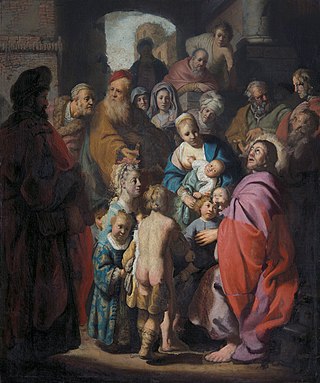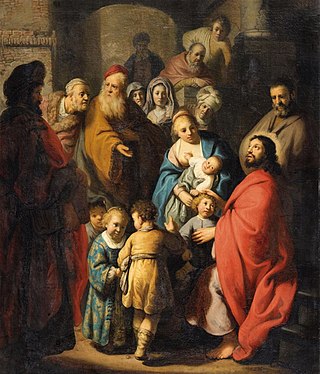Let the children come to me
| Let the children come to me |
|---|
| Rembrandt van Rijn |

|
| State 2018, during the restoration , |
| Oil on canvas ( relined ), 103.5 cm × 86 cm |
| Privately owned |
|
|

|
| State 2014, at the auction , |
Let the children come to me is an oil painting by a Dutch master from the 17th century depicting the blessing of Jesus as children . It was auctioned off in 2014 by the Cologne art auction house Lempertz as a work by an unidentified master from the Dutch Golden Age . In 2018, the Dutch art dealer Jan Six went public with the statement that the painting was a work by the young Rembrandt van Rijn painted in the mid-1620s .
description
The painting shows Jesus' blessing of children as described in the Gospels of the three synoptics ( Mt 19.13–15 EU , Mk 10.13–16 EU and Lk 18.15–17 EU ). Jesus Christ, seated on the right in the foreground, is dressed in a lilac robe and directs his gaze to the sky, from which a ray of light illuminates the part of the scene with him and the children. Two mothers are shown kneeling in front of Jesus and facing him on his right hand side, with them - in the illustrated state of partial restoration - six children of different ages, from infants to around ten years old. On the left edge of the picture, in the semi-darkness, stands a man who is dressed in a sumptuous robe and wearing a turban. Behind the group with Jesus, the mothers and the children, also as shown, there are eleven figures. It is mostly older men who observe the scene and apparently comment on it. Among these figures, the top representation, between a column and an archway at the upper edge of the picture, is the bust of a young man who has been identified as a self-portrait of Rembrandt. In front of the archway, wedged between a gesticulating, bearded old man in a red cap and a young woman in a headscarf, there is a small depiction of the face of an old woman in a headscarf. This woman is very similar to the portraits the young Rembrandt took of his mother, Neeltgen Willemsd. van Zuytbrouck, painted. The sky with the silhouette of a building with a tower is visible through the archway.
At the time of its discovery, the painting was largely painted over and gave the impression of a pastiche . Jesus wore a red robe, his features and hairstyle had been adapted to the later tastes of the time. The mother kneeling in front of Jesus, the face of an otherwise completely covered child and three of the men in the background had been completely painted over; the three men were replaced by a completely different man. The archway was painted over so that it appeared closed with masonry. The oldest boy standing in front of Jesus in the foreground was originally naked; he was completely painted over with the figure of a smaller boy dressed in a beige robe and boots. The painting was described as relined by the Lempertz auction house . It is still unclear whether the picture was not originally painted on wood and was only later transferred to a canvas.

|

|
|
|
Adolescent self-portrait , oil on panel, 15.5 × 12.7 cm, 1629, Alte Pinakothek , Munich
|
Let the children come to me (frame, self-portrait of Rembrandt)
|

|

|
|
|
Bust of an old woman , oil on panel, 61.3 × 47.5 cm, 1630/1631, Royal Collection , Windsor Castle , London
|
Let the children come to me (frame, portrait of an old woman)
|
In addition to the analysis of the style, the presence of two portraits in the painting, which are understood as a self-portrait of the young Rembrandt and a possible portrait of his mother, speaks in favor of the attribution to Rembrandt van Rijn. The depiction of a group of densely packed figures is reminiscent of early works by Rembrandt, such as Christ Driving the Money Changers from the Temple and The Stoning of St. Stephen . The stoning also shows the illumination of the main characters by a beam of light coming from the sky, and here, too, an observer in semi-darkness is shown on the left edge of the picture and a self-portrait of Rembrandt is placed in an inconspicuous place.
background
Possibly during his training with the painter Jacob Isaacsz van Swanenburgh from Leiden , Rembrandt learned the play with light and shadow, which later characterized his work and which appears in a rather rough form in his early work. Several of Rembrandt's early pictures, such as The Stoning of Saint Stephen and Balaam and the Donkey , show the illumination of parts of the motif by rays of light breaking out of the sky, which also distinguishes Let the children come to me . It was not unusual for Rembrandt to include a self-portrait or a portrait of someone close to him in a painting, especially for his early work. Rembrandt depicted himself again and again in different states of mind, apparently in order to learn how to depict emotions for his history paintings.
- Rembrandt's early works, around 1625
Christ drives the money changers out of the temple , oil on panel, 43.1 × 32 cm, 1624/1625, Pushkin Museum , Moscow
The stoning of St. Stephen , oil on panel, 89.5 × 123.6 cm, 1625, Musée des Beaux-Arts , Lyon
Balaam and the donkey , oil on panel, 65 × 47 cm, 1626, Musée Cognacq-Jay , Paris
auction
The painting was consigned to the 1029th "Old Masters" auction of the Cologne auction house Lempertz on May 17, 2014. It was accompanied by an expert opinion drawn up in 1954 by the art historian Ernst Heinrich Zimmermann , who at the time was General Director of the Former State Museums in Berlin (West) and attributed the painting to Govaert Flinck . The attribution to Flinck was quickly rejected, and the experts brought in by the Lempertz auction house gave different judgments. The picture was presented in the auction catalog with the heading Dutch Masters Mid-17th Century, Let the Children Come to Me ; the auction house referred to the picture as the work of one of his successors because of its clear echoes of Rembrandt's paintings. The estimate of 15,000 to 18,000 euros was based on this estimate.
During the auction, the bids rose quickly to 400,000 euros, one of the three remaining bidders got out at 900,000 euros. A bid of 1,508,000 euros (including a premium of 1,829,800 euros) was accepted by an initially unknown bidder from London; the second highest bid came from the US art dealer Otto Naumann . Only after the auction did Lempertz publicly associate the painting with Rembrandt.
restoration
The image has been examined without the findings being published and is taking several years to restore. The restoration of the painting includes the removal of the overpainting. Since the new paint adheres more strongly to the original painting than it does to the primer, removing it is a very laborious process. After some time with a British restorer, it turned out that he was overwhelmed with the work. The next restorer was Martin Bijl, who can look back on decades of experience with Dutch Old Masters and who was the head of the restoration workshop at the Rijksmuseum Amsterdam for many years . In the late summer of 2018, Bijl's order was withdrawn because Jan Six wanted to set him a very tight time frame with a view to the planned exhibition of the picture from November 2019, and Bijl only wanted to stop the rest of his business operations for an additional fee. Nothing further has been known about the progress of the restoration since then.
reception
Because it was discovered only a few years ago, the painting has not yet been mentioned in the art-historical literature. Its discoverer and the new owner have not given a statement for four years since the auction in 2014. In the late summer of 2018, the Dutch art dealer Jan Six went public and identified himself as the buyer. A few months earlier, in May 2018, he had become known as the discoverer and buyer of Rembrandt's portrait of a young man , which he had bought at Christie's in London for £ 137,000 two years earlier . Six, according to its own statements, bought Lasset the Children to Me with the help of an unnamed investor. He states that Ernst van de Wetering also considers the picture to be an early work by Rembrandt. Six wanted to keep the ownership of the painting secret until the restoration was completed, but was forced to step into the public eye because of rumors about a newly discovered Rembrandt. He is planning the exhibition of the painting as part of the exhibition The Young Rembrandt - Rising Star, which starts on November 2, 2019 at Museum De Lakenhal in Leiden .
The Dutch art historian Ernst van de Wetering commented positively on the painting in the daily press and called it a "huge find". It represents a phase in the development of the young Rembrandt, and under the overpaint there is a very special painting. Probably unfinished, but not unfinished in the sense that it would no longer be recognizable as Rembrandt after restoration.
Provenance
At the auction in 2014, initially only “German private property” was mentioned as to the origin, later it was stated that the painting came from Berlin. On the back is handwritten “v. Gellhorn ”noted. In 2014 the painting was sold by the Lempertz auction house to Jan Six and an unnamed investor.
Web links
- Lot 1174, Dutch master, mid-17th century, Let the children come to me , auction offer from the Lempertz auction house in Cologne for auction 1029 on May 17, 2014
Individual evidence
- ↑ a b c Johannes Böhme and Jan Six: What moves people. "A Monster Job" , Brand eins 2019, accessed on August 27, 2019.
- ↑ a b c Onno Blom and Michiel Kruijt: Jan Six weet het zeker: hij heeft nog een 'nieuwe' Rembrandt ontdekt , De Volkskrant , September 14, 2018, accessed on August 27, 2019.
- ^ Ernst van de Wetering: Rembrandt, a biography. In: Gemäldegalerie der Staatliche Museen zu Berlin (Ed.): Rembrandt. Genius in search. DuMont Literature and Art, Cologne 2006, ISBN 3-8321-7694-2 , pp. 21–49.
- ^ Ernst van de Wetering: Rembrandt's self-portraits: problems of authenticity and function. In: Stichting Foundation Rembrandt Research Project (Ed.): A Corpus of Rembrandt Paintings. IV. The self-portraits. Springer, Dordrecht 2005, ISBN 1-4020-3280-3 , pp. 89-317, especially pp. 158-178.
- ↑ Michael Parmentier: The painted me. About Rembrandt's self-images. In: Zeitschrift für Pädagogik 1997, vol. 43, no. 5, pp. 721–737, digitized .
- ↑ a b Lot 1174, Dutch master, mid-17th century, Let the children come to me , auction offer from the Lempertz auction house in Cologne for auction 1029 on May 17, 2014, accessed on August 27, 2019.
- ↑ a b Old Art - Sensational Price Increase - Rembrandt? , Press release from the Lempertz auction house dated May 19, 2014, accessed on August 27, 2019.
- ↑ a b Onno Blom: Art dealer Jan Six ontdekt wéér een 'nieuwe' Rembrandt , De Volkskrant , September 14, 2018, accessed on August 27, 2019.
- ↑ a b Arjen Ribbens: 'Mijn vriendschap met Jan Six is voorbij' (Interview with Ernst van de Wetering), NRC Handelsblad online, September 17, 2018, accessed on October 29, 2019.
- ↑ a b Art dealer Six claims to have discovered another Rembrandt , monopoly. Magazine for Art and Life , September 14, 2018, accessed on August 27, 2019.


